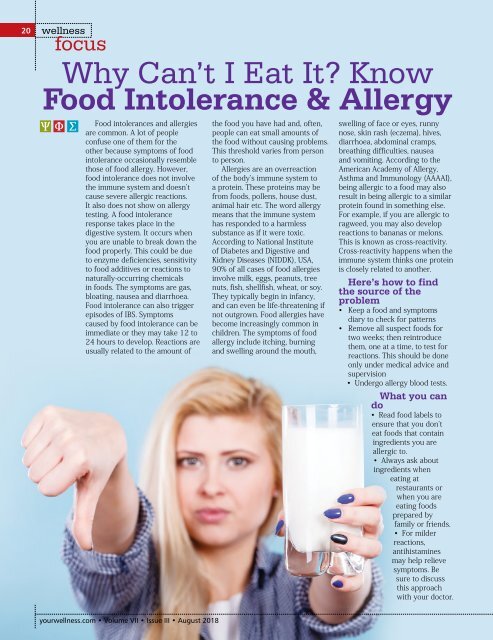You also want an ePaper? Increase the reach of your titles
YUMPU automatically turns print PDFs into web optimized ePapers that Google loves.
20 wellness<br />
focus<br />
Why Can’t I Eat It? Know<br />
Food Intolerance & Allergy<br />
Food intolerances and allergies<br />
are common. A lot of people<br />
confuse one of them for the<br />
other because symptoms of food<br />
intolerance occasionally resemble<br />
those of food allergy. However,<br />
food intolerance does not involve<br />
the immune system and doesn’t<br />
cause severe allergic reactions.<br />
It also does not show on allergy<br />
testing. A food intolerance<br />
response takes place in the<br />
digestive system. It occurs when<br />
you are unable to break down the<br />
food properly. This could be due<br />
to enzyme deficiencies, sensitivity<br />
to food additives or reactions to<br />
naturally-occurring chemicals<br />
in foods. The symptoms are gas,<br />
bloating, nausea and diarrhoea.<br />
Food intolerance can also trigger<br />
episodes of IBS. Symptoms<br />
caused by food intolerance can be<br />
immediate or they may take 12 to<br />
24 hours to develop. Reactions are<br />
usually related to the amount of<br />
the food you have had and, often,<br />
people can eat small amounts of<br />
the food without causing problems.<br />
This threshold varies from person<br />
to person.<br />
Allergies are an overreaction<br />
of the body’s immune system to<br />
a protein. These proteins may be<br />
from foods, pollens, house dust,<br />
animal hair etc. The word allergy<br />
means that the immune system<br />
has responded to a harmless<br />
substance as if it were toxic.<br />
According to National Institute<br />
of Diabetes and Digestive and<br />
Kidney Diseases (NIDDK), USA,<br />
90% of all cases of food allergies<br />
involve milk, eggs, peanuts, tree<br />
nuts, fish, shellfish, wheat, or soy.<br />
They typically begin in infancy,<br />
and can even be life-threatening if<br />
not outgrown. Food allergies have<br />
become increasingly common in<br />
children. The symptoms of food<br />
allergy include itching, burning<br />
and swelling around the mouth,<br />
swelling of face or eyes, runny<br />
nose, skin rash (eczema), hives,<br />
diarrhoea, abdominal cramps,<br />
breathing difficulties, nausea<br />
and vomiting. According to the<br />
American Academy of Allergy,<br />
Asthma and Immunology (AAAAI),<br />
being allergic to a food may also<br />
result in being allergic to a similar<br />
protein found in something else.<br />
For example, if you are allergic to<br />
ragweed, you may also develop<br />
reactions to bananas or melons.<br />
This is known as cross-reactivity.<br />
Cross-reactivity happens when the<br />
immune system thinks one protein<br />
is closely related to another.<br />
Here’s how to find<br />
the source of the<br />
problem<br />
• Keep a food and symptoms<br />
diary to check for patterns<br />
• Remove all suspect foods for<br />
two weeks; then reintroduce<br />
them, one at a time, to test for<br />
reactions. This should be done<br />
only under medical advice and<br />
supervision<br />
• Undergo allergy blood tests.<br />
What you can<br />
do<br />
• Read food labels to<br />
ensure that you don’t<br />
eat foods that contain<br />
ingredients you are<br />
allergic to.<br />
• Always ask about<br />
ingredients when<br />
eating at<br />
restaurants or<br />
when you are<br />
eating foods<br />
prepared by<br />
family or friends.<br />
• For milder<br />
reactions,<br />
antihistamines<br />
may help relieve<br />
symptoms. Be<br />
sure to discuss<br />
this approach<br />
with your doctor.<br />
yourwellness.com • Volume VII • Issue III • <strong>August</strong> <strong>2018</strong>




